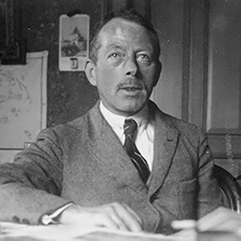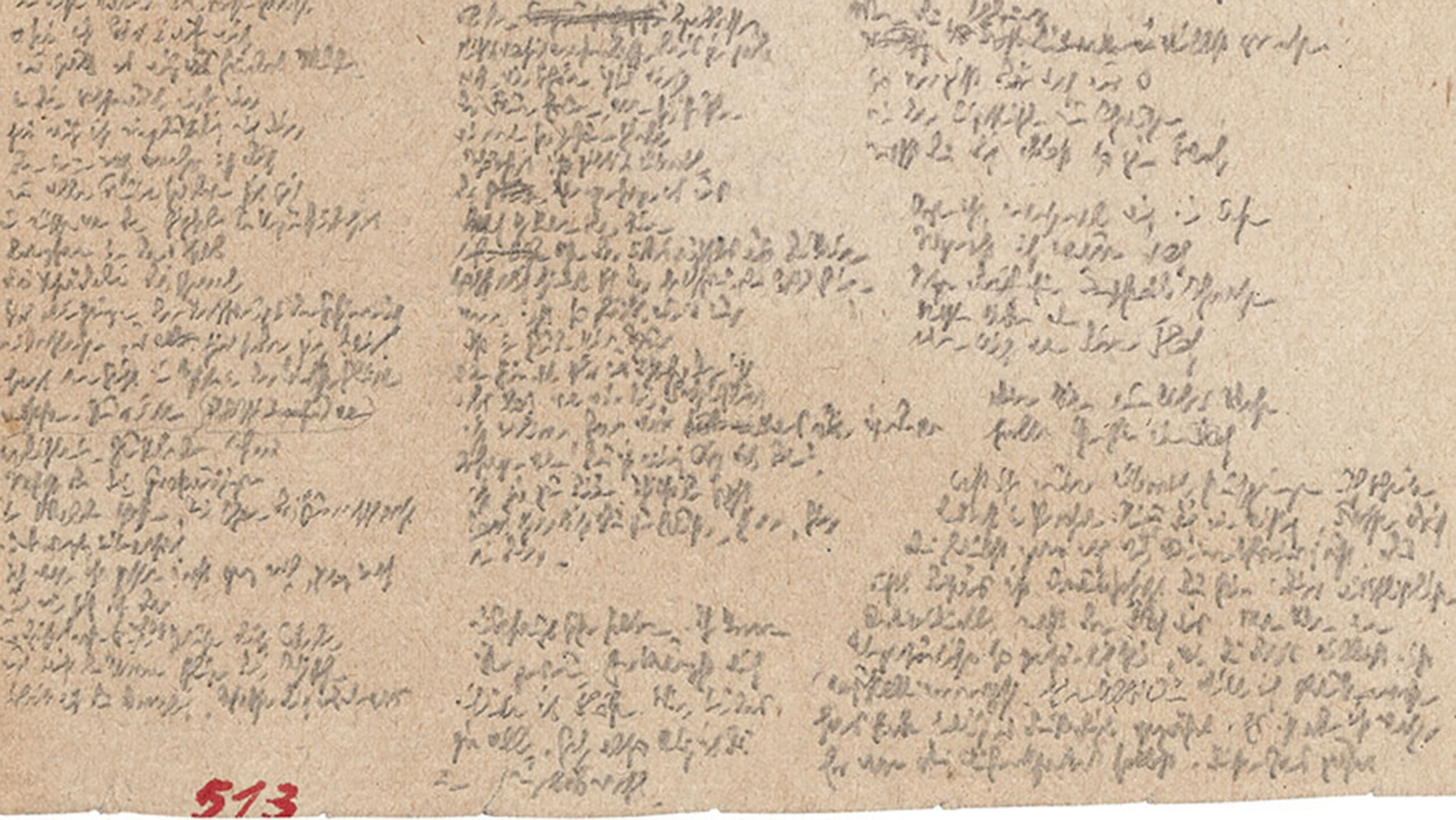Walser’s Lab
A literary legacy riddled with mysteries: When Swiss writer Robert Walser (1878-1956) died, he left behind not just his three published novels and numerous shorter texts published in newspapers and journals across Europe, but also 526 loose-leaf sheets of paper completely filled with minute pencil handwriting. In some cases he tightly packed several miniature texts onto one single page.
When these microscripts were first discovered, they were initially thought to be unreadable. Walser had kept the papers hidden during his own lifetime, and it was even rumored that he had used an indecipherable secret code. That is, until two Walser researchers, Jochen Greven and Martin Jürgens, managed to decode some of the microscripts. Subsequently, literary scholars Bernhard Echter and Werner Morlang spent years painstakingly preparing a selection of the 526 pages for publication. Between 1985 and 2000, the texts were published in a series entitled Aus dem Bleistiftgebiet, meaning “from the pencil zone” (some of which were later published in English as Microscripts translated by Susan Bernofsky).
50 volumes of Walser
“The story about the secret code is one of many myths surrounding the enigmatic figure of Robert Walser,” says Angela Thut. “But actually the microscripts are written in normal German script, albeit only a few millimeters high, and with patience and practice they’re usually quite legible.” The UZH Germanist is a specialist in Walser’s microscripts, and has been studying the Swiss author’s work for many years.
Together with her colleagues Christian Walt and Fabian Grossenbacher, Thut works on the joint academic project of the universities of Basel and Zurich, the Kritische Robert Walser-Ausgabe. Since its launch in 2007, the project’s aim has been to produce and publish critical editions of Walser’s complete texts and handwritten documents in around 50 volumes. The initiator of the project was the Zurich professor of German language and literature Wolfram Groddeck, now retired. He and Basel researcher Barbara von Reibnitz share the main responsibility for the publications. The literature experts have now reached the halfway point in their mammoth project: The 25th book in the series has just been published. The handsome volume contains several microscripts of varying lengths written by Walser in Bern in 1925.
Meandering motifs
After his literary beginnings in Switzerland, Robert Walser spent the years 1905 to 1913 in Berlin trying to build a career as a writer. There he wrote (in fair copy using pen and ink) his three novels The Tanners, The Assistant and Jakob von Gunten. But success remained elusive and Walser returned to his hometown of Biel, nursing a sense of failure.
In 1921 he moved to Bern, where he began producing the legendary microscripts. No more novels were published during this period, but newspapers and journals continued to publish shorter texts by Walser. In this later creative phase, he continued to be extremely productive, as can be seen from the microscripts: If the text on the 526 scraps of paper were printed conventionally, it would reach 5,000 to 6,000 pages. With the new editions, the vast scope of Walser’s work and its context can now be better appreciated.

The loose-leaf sheets were something like a literary test lab for Robert Walser – a breeding ground for new ideas. He used them to develop new texts, sometimes several at a time on one piece of paper. These adjacent stories then infected one another like germs in a petri dish. “We can see how certain motifs meander in and out of Walser’s microscripts,” says Thut. The Kritische Robert Walser-Ausgabe, which is now publishing the complete microscripts with contextual information for the first time, makes it possible to trace these meandering threads. Alongside high-resolution facsimiles of the original handwritten pages, the edition contains more readable (but also small) printed versions of the texts, which reproduce exactly the form of the microscript pages. In addition, the miniatures are printed in normal type including all the corrections and improvements made by the author.
This three-stage process enables readers to conduct a nuanced examination of Walser’s microscripts and thus gain new insights into the writer’s work processes. “Critical scholarly editions such as these act as a catalyst for interesting novel research,” believes UZH professor of literature and Walser enthusiast Davide Giuriato. Indeed, numerous dissertations have already been written in connection with the Kritische Robert Walser-Ausgabe.
Writing is more than thinking
For Giuriato, the microscripts are evidence of Robert Walser’s modernity as a writer. Modernist authors such as Friedrich Nietzsche, Thomas Mann and Walser were intensely preoccupied with the physical aspect of writing. For them, writing was not just an intellectual but also a manual pursuit. Thus they sought out suitable materials with which to write, worked in inspiring surroundings, and developed their own specific writing methods. Nietzsche, for example, experimented with typewriters. “In literary studies we talk about the aesthetics of production,” says Giuriato. It’s an aspect of writing which has gained in importance. With his microscripts, Robert Walser discovered a truly unique and idiosyncratic literary method, and in the pencil he found his ideal tool.
Struggling with the novel
During his time in Bern, Walser wrote mainly poetry and short prose pieces. He managed to get his work published in newspapers in Berlin, Prague, Vienna and Budapest. For the newspapers, Walser would make a fair copy of his microscripts in larger handwriting and send them to the editors. But over half of the miniature texts remained unpublished, including Walser’s final attempt at a novel.
The draft of the novel, dubbed Der Räuber (the robber), is part of the newly published 25th volume of the Kritische Robert Walser-Ausgabe. The protagonist is a social outsider, the robber, whose sole occupation apart from writing is wooing women and who is therefore despised by the prevailing bourgeoisie among whom only business and money count. “Actually the text has no plot, or at least not a straightforward one,” says Giuriato. The story goes off on various tangents, and in the end the narration itself becomes the main subject. Although not published in Walser’s lifetime, Der Räuber appeared posthumously with Suhrkamp Verlag in 1972, marketed as a novel (English translation The Robber by Susan Bernofsky, University of Nebraska Press, 2000). The new critical edition, rather than treating it as a finished novel, clearly shows the work’s draft qualities, thus opening it up to a new reading.
Robert Walser was not alone in struggling to write a novel. Other great writers of modernist literature such as Franz Kafka and Robert Musil failed to complete planned novels, says Giuriato. After his admission to a sanatorium in Herisau (Appenzell Ausserrhoden) in 1933, Robert Walser largely gave up writing altogether. The reasons for his decision to lay down his pencil are unclear – another mystery in the life and work of the great master of the small.
This text first appeared in the UZH Magazine UZH Magazin 3/2021
